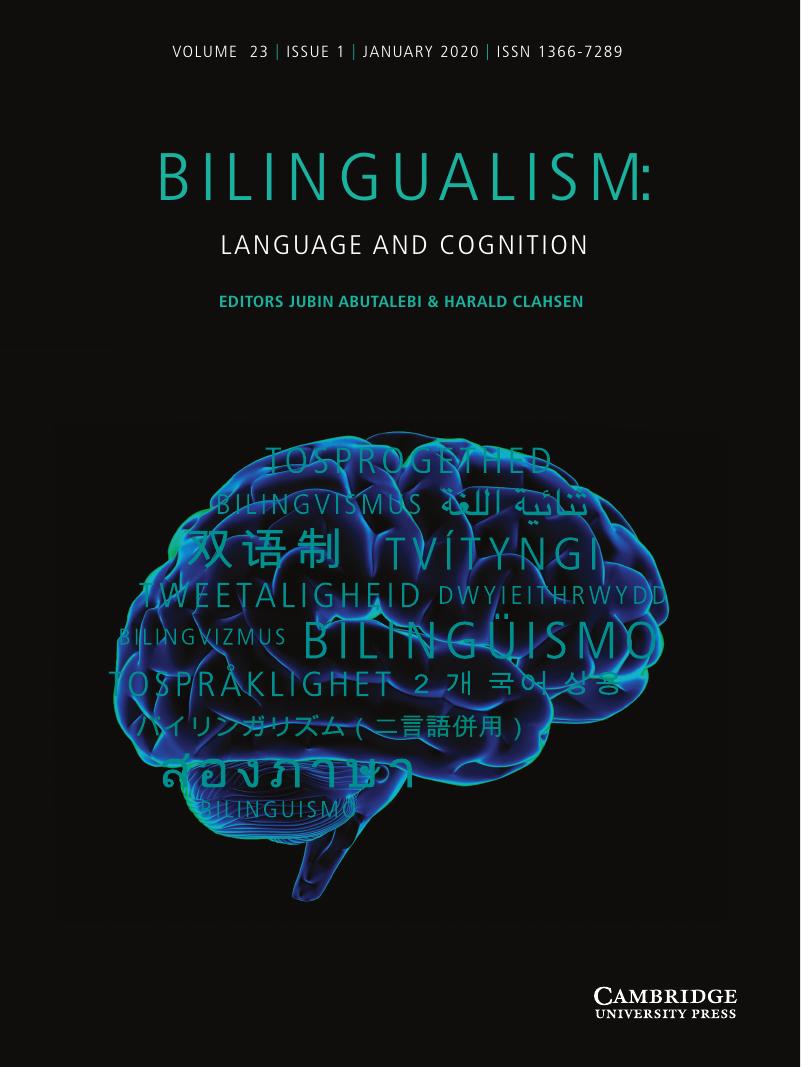【限时资源,期刊全文】Bilingualism:Language and Cognition(《双语:语言和认知》)2019年全5卷论文集(侵删)
1635 阅读 19 下载 2020-06-24 18:13:59 上传 29.94 MB
本期推送的是SSCI期刊Bilingualism:Language and Cognition(《双语:语言和认知》)2019年全5卷论文集(即第22卷1-5期共83篇论文),其中目录可以在正文中查看,全文可以于即日起3天内点击文末附件列
Bilingualism:Language and Cognition(《双语:语言和认知》)2019年全5卷83篇论文
资料整理:张明辉(微信:zhangxiaojian160408)
(下载链接3天内有效,失效后若仍想要全文,请加小编微信联系)

| 卷号 | 期号 | 论文号 | 论文题目 |
| Vol. 22 | Issue 1 | Article 01 | Relations between vocabulary and executive functions in Spanish–English dual language learners |
| Vol. 22 | Issue 1 | Article 02 | A multilingual advantage in the components of working memory |
| Vol. 22 | Issue 1 | Article 03 | The auditory and visual appraisal of emotion-related words in Spanish–English bilinguals |
| Vol. 22 | Issue 1 | Article 04 | Language-dependent knowledge acquisition: investigating bilingual arithmetic learning |
| Vol. 22 | Issue 1 | Article 05 | Lexical entrenchment and cross-language activation: Two sides of the same coin for bilingual reading across the adult lifespan |
| Vol. 22 | Issue 1 | Article 06 | Individual differences predict ERP signatures of second language learning of novel grammatical rules |
| Vol. 22 | Issue 1 | Article 07 | Similar and distinct neural mechanisms underlying semantic priming in the languages of the French–Spanish bilingual children |
| Vol. 22 | Issue 1 | Article 08 | Reading Pinyin activates character orthography for highly experienced learners of Chinese |
| Vol. 22 | Issue 1 | Article 09 | Gender congruency effects in Russian–Spanish and Italian–Spanish bilinguals: The role of language proximity and concreteness of words |
| Vol. 22 | Issue 1 | Article 10 | Misbehaved masculines: Incidental acquisition of grammatical gender in L2 German during reading |
| Vol. 22 | Issue 1 | Article 11 | The effects of script variation, literacy skills, and immersion experience on executive attention: A comparison of matched monoscriptal and biscriptal bilinguals |
| Vol. 22 | Issue 1 | Article 12 | Target accessibility contributes to asymmetric priming in translation and cross-language semantic priming in unbalanced bilinguals |
| Vol. 22 | Issue 1 | Article 13 | Lexical and semantic connections in number words translation |
| Vol. 22 | Issue 1 | Article 14 | Select The influence of bilingualism on working memory event-related potentials |
| Vol. 22 | Issue 1 | Article 15 | Bilingualism reveals fundamental variation in language processing |
| Vol. 22 | Issue 2 | Article 16 | Crosslinguistic interplay between semantics and phonology in late bilinguals: neurophysiological evidence |
| Vol. 22 | Issue 2 | Article 17 | Conflict monitoring and detection in the bilingual brain |
| Vol. 22 | Issue 2 | Article 18 | Electrophysiological correlates of categorical perception of lexical tones by English learners of Mandarin Chinese: an ERP study |
| Vol. 22 | Issue 2 | Article 19 | The effect of task complexity on linguistic and non-linguistic control mechanisms in bilingual aphasia |
| Vol. 22 | Issue 2 | Article 20 | Revisiting the Revised Hierarchical Model: Evidence for concept mediation in backward translation |
| Vol. 22 | Issue 2 | Article 21 | The influence of proficiency and language combination on bilingual lexical access |
| Vol. 22 | Issue 2 | Article 22 | Bilingual memory, to the extreme: Lexical processing in simultaneous interpreters |
| Vol. 22 | Issue 2 | Article 23 | Language and literacy skills of home and international university students: How different are they, and does it matter? |
| Vol. 22 | Issue 2 | Article 24 | Code-switching does not predict Executive Function performance in proficient bilingual children: Bilingualism does |
| Vol. 22 | Issue 2 | Article 25 | The predictors of foreign-accentedness in the home language of Polish–English bilingual children |
| Vol. 22 | Issue 2 | Article 26 | Describing bilinguals: A systematic review of labels and descriptions used in the literature between 2005–2015 |
| Vol. 22 | Issue 2 | Article 27 | A prosodic bias, not an advantage, in bilinguals' interpretation of emotional prosody |
| Vol. 22 | Issue 3 | Article 28 | Persistent differences between native speakers and late bilinguals: Evidence from inflectional and derivational processing in older speakers |
| Vol. 22 | Issue 3 | Article 29 | Cross-linguistic activation of implicit causality biases in Korean learners of English |
| Vol. 22 | Issue 3 | Article 30 | A Bayesian approach to establishing coreference in second language discourse: Evidence from implicit causality and consequentiality verbs |
| Vol. 22 | Issue 3 | Article 31 | The impact of cross-language phonological overlap on bilingual and monolingual toddlers’ word recognition |
| Vol. 22 | Issue 3 | Article 32 | Noticing vocabulary holes aids incidental second language word learning: An experimental study |
| Vol. 22 | Issue 3 | Article 33 | When a seven is not a seven: Self-ratings of bilingual language proficiency differ between and within language populations |
| Vol. 22 | Issue 3 | Article 34 | Bilingual lexical access: A dynamic operation modulated by word-status and individual differences in inhibitory control |
| Vol. 22 | Issue 3 | Article 35 | On the flexibility of bilingual language control: The effect of language context |
| Vol. 22 | Issue 3 | Article 36 | Lexical selection, cross-language interaction, and switch costs in habitually codeswitching bilinguals |
| Vol. 22 | Issue 3 | Article 37 | Cognitive control among immersed bilinguals: Considering differences in linguistic and non-linguistic processing |
| Vol. 22 | Issue 3 | Article 38 | A domain-general monitoring account of language switching in recognition tasks: Evidence for adaptive control |
| Vol. 22 | Issue 3 | Article 39 | Symmetries of bilingual language switch costs in conflicting versus non-conflicting contexts |
| Vol. 22 | Issue 3 | Article 40 | The effects of language dominance switch in bilinguals: Galician new speakers' speech production and perception |
| Vol. 22 | Issue 4 | Article 41 | Computational approaches to word retrieval in bilinguals |
| Vol. 22 | Issue 4 | Article 42 | Multilink: a computational model for bilingual word recognition and word translation |
| Vol. 22 | Issue 4 | Article 43 | The bilingual mental lexicon beyond Dutch–English written words |
| Vol. 22 | Issue 4 | Article 44 | Scaling up: How computational models can propel bilingualism research forward |
| Vol. 22 | Issue 4 | Article 45 | The role of learning on bilinguals’ lexical architecture: Beyond separated vs. integrated lexicons |
| Vol. 22 | Issue 4 | Article 46 | Multilink for bilingual language production |
| Vol. 22 | Issue 4 | Article 47 | Words only go so far: Linguistic context affects bilingual word processing |
| Vol. 22 | Issue 4 | Article 48 | A few suggestions on broadening the cross-linguistic relevance of the Multilink model |
| Vol. 22 | Issue 4 | Article 49 | Phonology-based bilingual activation among different-script bilinguals? |
| Vol. 22 | Issue 4 | Article 50 | The need for a universal computational model of bilingual word recognition and word translation |
| Vol. 22 | Issue 4 | Article 51 | The critical roles of errors and individual differences in bilingual translation |
| Vol. 22 | Issue 4 | Article 52 | On keeping cool: The role of inhibition in bilingual word processing |
| Vol. 22 | Issue 4 | Article 53 | Language membership as a gradient emergent feature |
| Vol. 22 | Issue 4 | Article 54 | Modelling bilingual lexical processing: A research agenda and desiderabilia |
| Vol. 22 | Issue 4 | Article 55 | Early executive function: The influence of culture and bilingualism |
| Vol. 22 | Issue 4 | Article 56 | Bilingual experience and executive control over the adult lifespan: The role of biological sex |
| Vol. 22 | Issue 4 | Article 57 | Enhanced temporal binding of audiovisual information in the bilingual brain |
| Vol. 22 | Issue 4 | Article 58 | Novel-word learning, executive control and working memory: A bilingual advantage |
| Vol. 22 | Issue 4 | Article 59 | Bilingual exposure enhances left IFG specialization for language in children |
| Vol. 22 | Issue 4 | Article 60 | Language background affects online word order processing in a second language but not offline |
| Vol. 22 | Issue 4 | Article 61 | “My French is rusty”: Proficiency and bilingual gesture use in a majority English community |
| Vol. 22 | Issue 4 | Article 62 | Having a different pointing of view about the future: The effect of signs on co-speech gestures about time in Mandarin–CSL bimodal bilinguals |
| Vol. 22 | Issue 4 | Article 63 | The illusory benefit of cognates: Lexical facilitation followed by sublexical interference in a word typing task |
| Vol. 22 | Issue 4 | Article 64 | Second language (L2) proficiency, socioeconomic status (SES), and intelligence (IQ) are significant predictors of cognitive control differences among young adult unbalanced Chinese–English bilinguals |
| Vol. 22 | Issue 4 | Article 65 | Effect of speaker certainty on novel word learning in monolingual and bilingual children |
| Vol. 22 | Issue 5 | Article 66 | Native and non-native (L1-Mandarin) speakers of English differ in online use of verb-based cues about sentence structure |
| Vol. 22 | Issue 5 | Article 67 | Processing foreign-accented speech in a second language: Evidence from ERPs during sentence comprehension in bilinguals |
| Vol. 22 | Issue 5 | Article 68 | The nature of first and second language processing: The role of cognitive control and L2 proficiency during text-level comprehension |
| Vol. 22 | Issue 5 | Article 69 | Using clausal embedding to identify language impairment in sequential bilinguals |
| Vol. 22 | Issue 5 | Article 70 | The central processing bottleneck during word production: Comparing simultaneous interpreters, bilinguals and monolinguals |
| Vol. 22 | Issue 5 | Article 71 | Effects of home language input on the vocabulary knowledge of sequential bilingual children |
| Vol. 22 | Issue 5 | Article 72 | A comparison of verb and noun retrieval in Mandarin–English bilinguals with English-speaking monolinguals |
| Vol. 22 | Issue 5 | Article 73 | What do I choose? Influence of interlocutor awareness on bilingual language choice during voluntary object naming |
| Vol. 22 | Issue 5 | Article 74 | Bilingualism as a desirable difficulty: Advantages in word learning depend on regulation of the dominant language |
| Vol. 22 | Issue 5 | Article 75 | Language dominance predicts cognate effects and inhibitory control in young adult bilinguals |
| Vol. 22 | Issue 5 | Article 76 | Robustness of phonolexical representations relates to phonetic flexibility for difficult second language sound contrasts |
| Vol. 22 | Issue 5 | Article 77 | Now you hear it, now you don't: Malleable illusory vowel effects in Spanish–English bilinguals |
| Vol. 22 | Issue 5 | Article 78 | Explicit and implicit aptitude effects on second language speech learning: Scrutinizing segmental and suprasegmental sensitivity and performance via behavioural and neurophysiological measures |
| Vol. 22 | Issue 5 | Article 79 | When blue is a disyllabic word: Perceptual epenthesis in the mental lexicon of second language learners |
| Vol. 22 | Issue 5 | Article 80 | Linguistic immersion and structural effects on the bilingual brain: a longitudinal study |
| Vol. 22 | Issue 5 | Article 81 | Bilinguals as “experts”? Comparing performance of mono- to bilingual individuals via a mousetracking paradigm |
| Vol. 22 | Issue 5 | Article 82 | A diffusion model approach to analyzing performance on the Flanker task: The role of the DLPFC |
| Vol. 22 | Issue 5 | Article 83 | Exploring the relationship between multilingualism and tolerance of ambiguity: A survey study from an EFL context |
所需积分:0 分
限期开放已结束
表情
图片
附件













